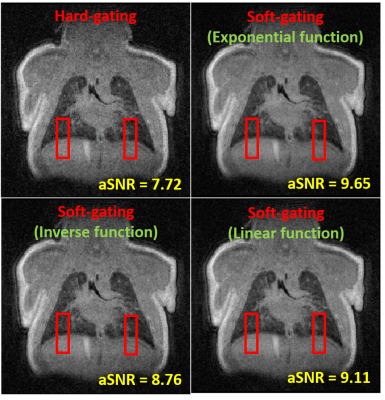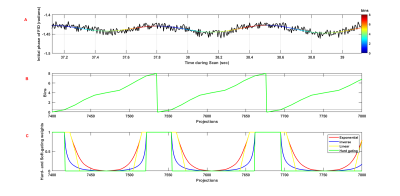Deep B. Gandhi1, Nara S. Higano2, Andrew D. Hahn3, Luis Torres3, Sean B. Fain3, Jason C. Woods2, and Alister J. Bates2
1Department of Radiology, Cincinnati Children's Hospital Medical Center, Cincinnati, OH, United States, 2Pulmonary Medicine, Cincinnati Children's Hospital Medical Center, Cincinnati, OH, United States, 3Department of Medical Physics, University of Wisconsin, Madison, WI, United States
1Department of Radiology, Cincinnati Children's Hospital Medical Center, Cincinnati, OH, United States, 2Pulmonary Medicine, Cincinnati Children's Hospital Medical Center, Cincinnati, OH, United States, 3Department of Medical Physics, University of Wisconsin, Madison, WI, United States
Soft-gating weighted lung UTE-MRI reconstruction provides
higher aSNR compared to hard-gating. Exponential and linearly weighted
soft-gating functions provide improved trade-off in terms of aSNR and motion
blurring at lung-diaphragm boundary compared to inverse weighting
functions.

Figure 2. Images
reconstructed using hard-gating and 3 soft-gating weighting functions
(exponential, inverse and linear). aSNR for each reconstructed image using the
different weighting function is based on the optimized parameter for each
weighting function. Area in the red rectangle encompasses the superior-inferior
lines used to generate linearly scaled mean signal intensity profiles at the
lung-diaphragm boundary in figure 3.

Figure 1. (A) A smoothed
waveform fit through initial phase of free induction decay (FID) with data
binned into 8 different bins from 0 to 7. (B) Bin assignment of the data based
on the median wave in (A), where bin 8 represents bulk-motion and is discarded.
(C) Hard-gating and three soft-gating weighting functions (exponential, inverse
and linear) shown here with respect to Bin 0.